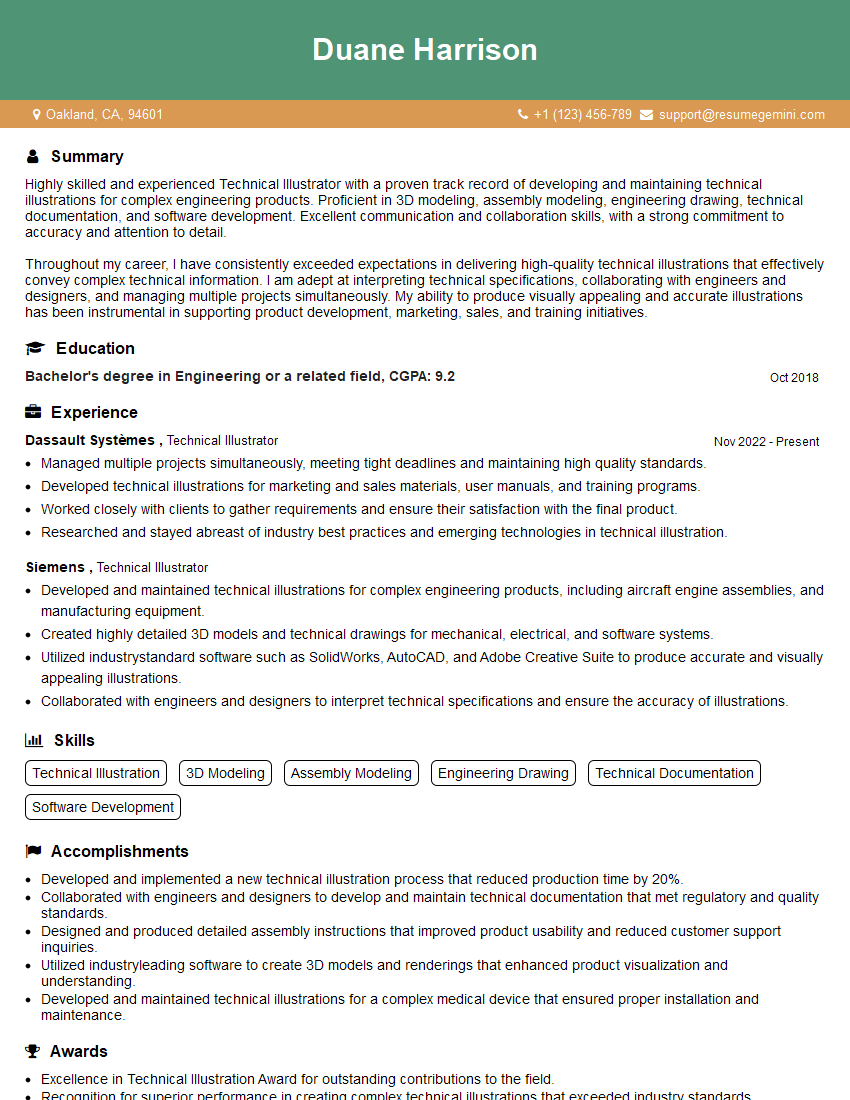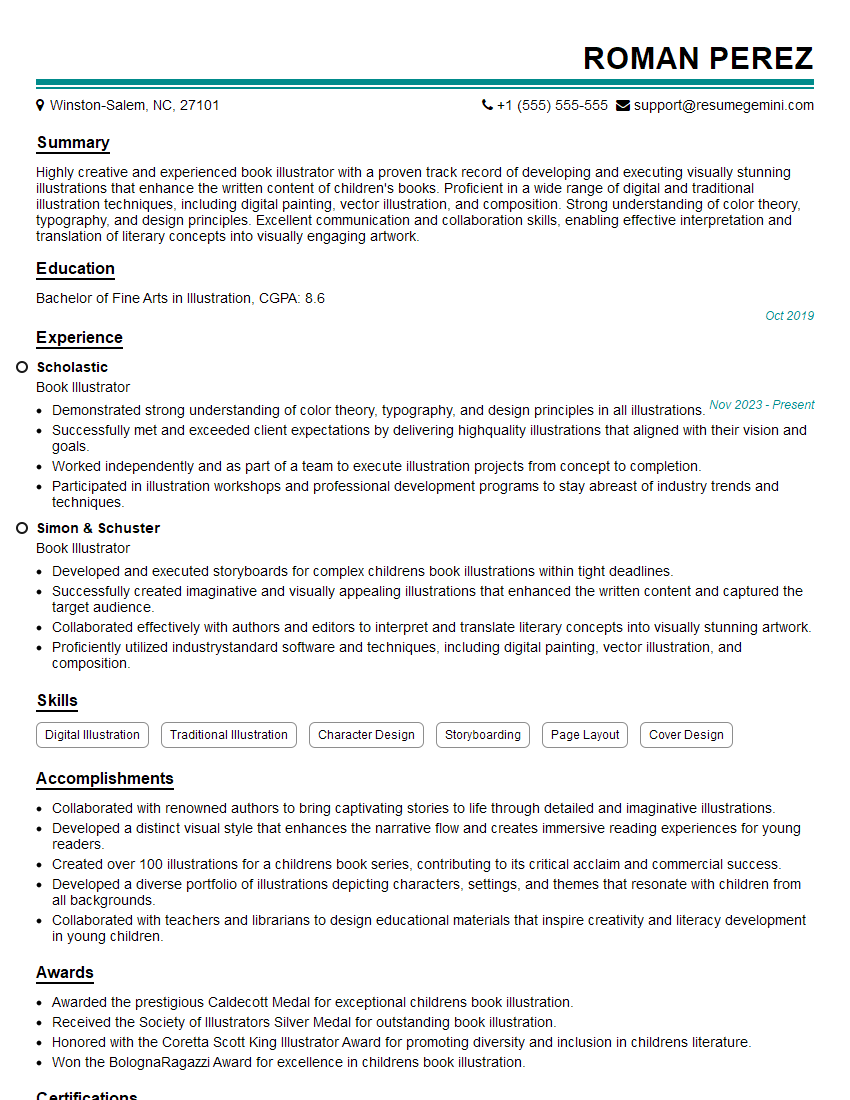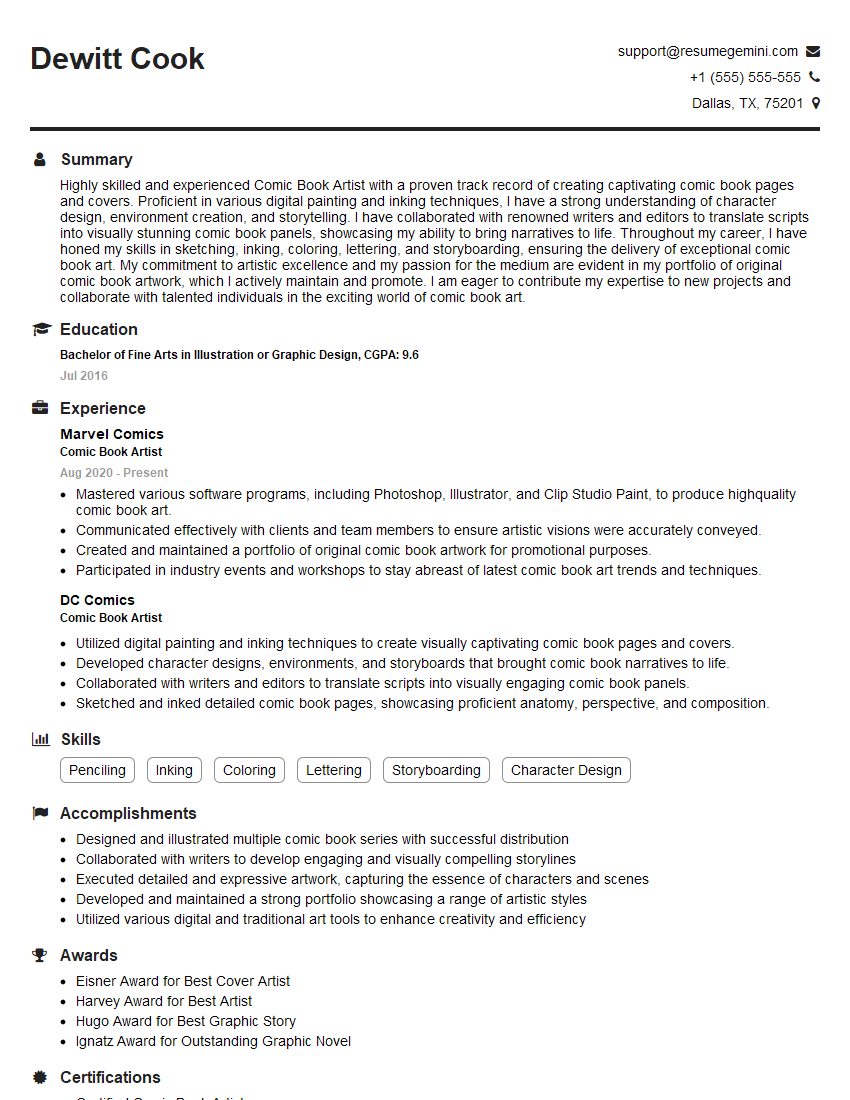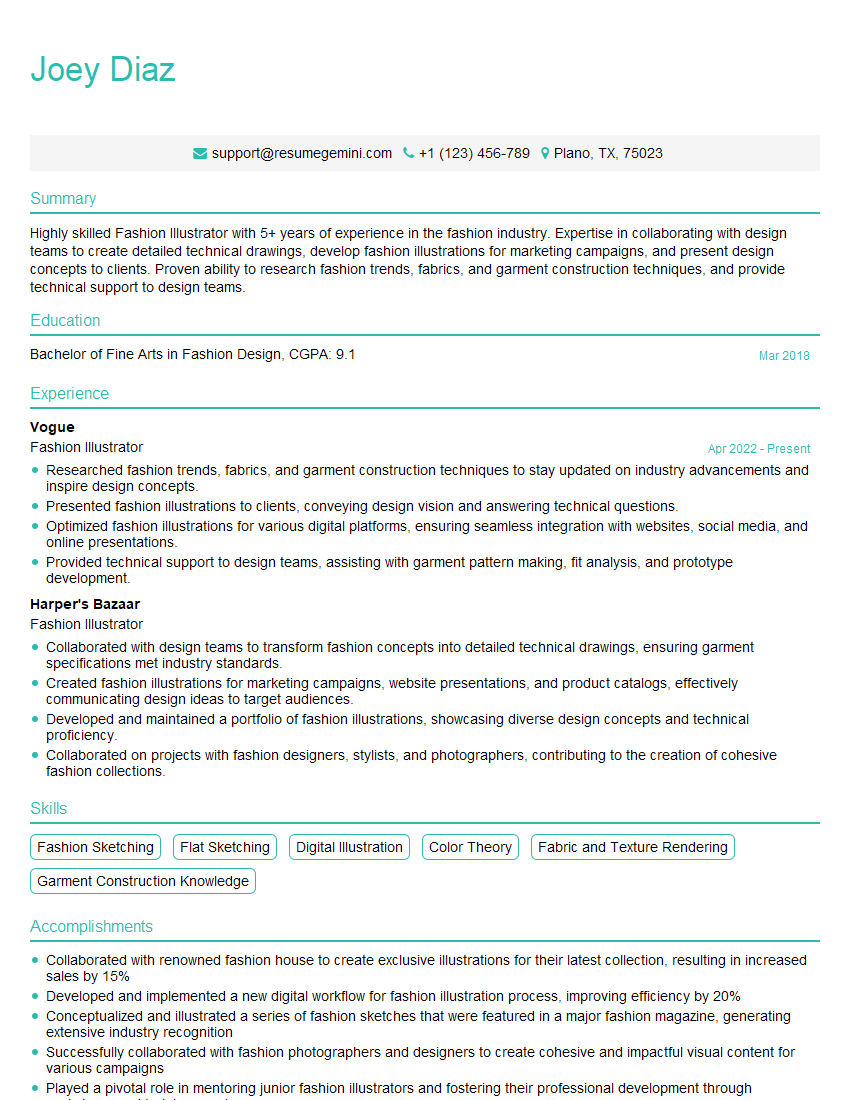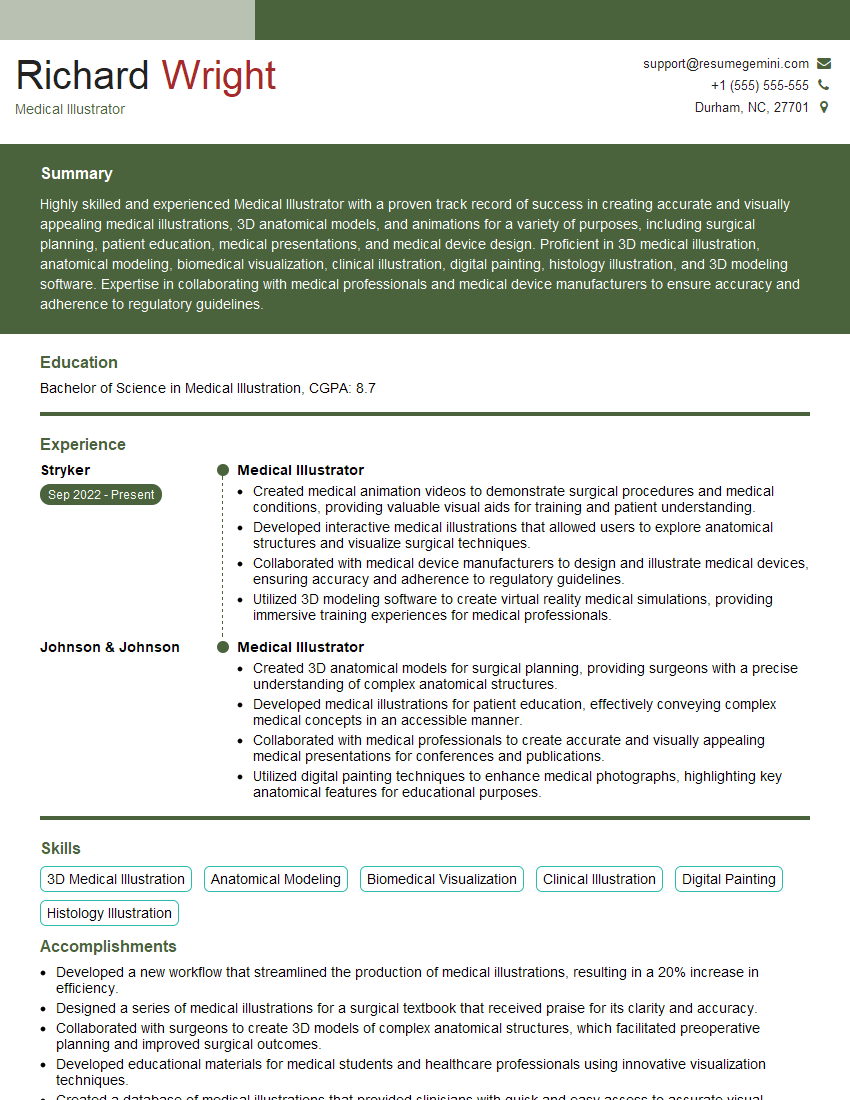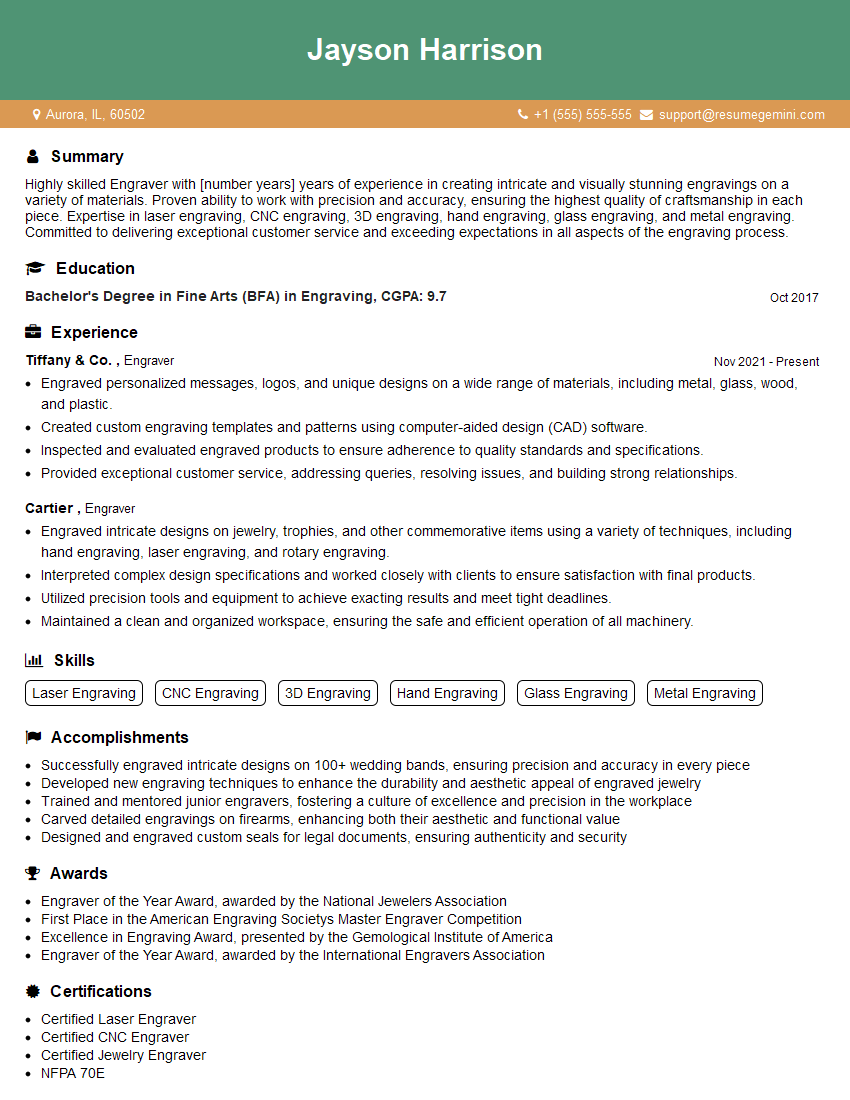Every successful interview starts with knowing what to expect. In this blog, we’ll take you through the top Pen and Ink Drawing interview questions, breaking them down with expert tips to help you deliver impactful answers. Step into your next interview fully prepared and ready to succeed.
Questions Asked in Pen and Ink Drawing Interview
Q 1. Explain your preferred pen and ink techniques.
My preferred pen and ink techniques revolve around a combination of hatching, cross-hatching, stippling, and line variation to create form, texture, and value. I don’t stick to a single rigid style; instead, I adapt my approach to the subject matter. For example, a detailed architectural drawing might heavily utilize precise hatching and cross-hatching for sharp definition, while a more expressive landscape piece might incorporate looser stippling and varied line weights to capture a sense of movement and atmosphere.
Hatching involves creating parallel lines to suggest shading; the closer the lines, the darker the tone. Cross-hatching adds another layer of lines at an angle to the first, increasing the depth of shadow. Stippling uses small dots, varying in density, to build up tone and texture – think of it like pointillism but with a pen. Line variation, adjusting the weight and pressure applied to the pen, adds dynamism and emphasizes certain areas of the composition.
Q 2. Describe your experience with different pen types (e.g., dip pens, fountain pens, technical pens).
I’ve worked extensively with various pen types, each offering unique qualities. Dip pens provide the most control and allow for incredible line variation, but require more preparation and maintenance. I love the expressiveness they offer, the way the ink flow can be manipulated subtly, resulting in beautiful textural effects. However, they’re not ideal for large-scale projects or fast sketching.
Fountain pens are excellent for longer drawing sessions due to their consistent ink flow. The nib flexibility varies widely depending on the model, permitting a range of line weights. For precise, consistent lines, technical pens are unsurpassed. Their consistent ink flow and precise tips are perfect for architectural renderings or detailed illustrations where unwavering line quality is crucial. I often combine these pen types in a single piece, choosing the tool best suited for the task at hand.
Q 3. How do you achieve varying line weights and textures in your pen and ink work?
Achieving varying line weights and textures is fundamental to creating compelling pen and ink drawings. The primary method is pressure control – applying more pressure creates thicker lines, while lighter pressure produces thinner ones. This works well with flexible nib dip pens and some fountain pens. With technical pens, achieving varied line weight is more challenging, usually requiring the use of different nib sizes.
Beyond pressure control, changing the angle of the pen on the paper can also impact line weight, particularly with dip pens. Varying the spacing between lines (in hatching and cross-hatching) also affects the tonal range. Finally, the type of ink used can subtly affect line texture – some inks produce smoother lines than others.
Q 4. Discuss your approach to creating value and shading using only pen and ink.
Value and shading in pen and ink rely on manipulating line density and spacing. Darker areas are rendered using closely spaced lines or densely packed stippling, while lighter areas utilize wider spacing or fewer dots. The transition between light and dark should be gradual, avoiding abrupt changes which can look artificial.
Think of it like building up tone gradually. You might start with a base layer of light hatching, then add another layer of cross-hatching to darken certain areas further. Stippling can be layered similarly; a sparse stipple creates a light tone, building to a darker tone through denser stippling. Blending these techniques effectively is key to achieving a sense of depth and realism.
Q 5. What are your preferred inks and paper types, and why?
My preferred inks are waterproof, archival-quality drawing inks like those from Higgins or Sumi ink. Waterproof inks prevent smudging and are crucial for layering. Archival quality ensures the longevity of my artwork, preventing fading over time. For paper, I favour smooth, heavyweight cartridge paper or illustration board; the smooth surface allows for fine detail and prevents the ink from feathering. The weight of the paper is important to prevent bleed-through, especially when working with multiple layers of ink.
The choice of ink and paper are not arbitrary; they significantly influence the final look and feel of the drawing. Experimentation with different inks and paper is encouraged to discover what best suits your style and the specific demands of the project.
Q 6. How do you plan and sketch before beginning a pen and ink drawing?
My approach to planning begins with preliminary sketches, often using a light pencil to block in the composition and define major forms. I focus on the overall structure, proportions, and values. This stage doesn’t need to be overly detailed; it serves as a roadmap for the ink work.
Sometimes I use a light wash of watercolor or dilute ink to indicate areas of light and shadow. This pre-planning allows me to avoid working blindly with ink, saving time and preventing mistakes. Careful consideration of composition and value ranges at this stage significantly improves the final pen and ink drawing.
Q 7. Describe your process for correcting mistakes in pen and ink drawings.
Correcting mistakes in pen and ink is challenging because it’s a medium that demands precision. There’s no simple “undo” button. My strategy focuses on prevention through careful planning. However, if mistakes occur, I may employ a few techniques.
For minor imperfections, a very fine, opaque white gouache or acrylic paint can be used to carefully cover the mistake. However, this must be done delicately to avoid disrupting the surrounding ink work. If the mistake is larger, I might strategically incorporate it into the drawing, perhaps transforming it into a shadow or textural element. In extreme cases, it may be necessary to start the drawing anew, having learned from my mistakes. That’s why planning and a light touch are so crucial.
Q 8. How do you approach creating detail and precision in your work?
Achieving detail and precision in pen and ink drawing relies on a combination of technical skill and mindful practice. It’s not just about the tools, but about understanding how to control them.
Firstly, line control is paramount. This involves developing a steady hand and mastering different pen pressures to create varying line weights. Think of it like writing – a light touch produces fine lines, while firmer pressure yields bolder strokes. Practice exercises like drawing continuous lines, hatching patterns, and varying line weights across a page will significantly improve this.
Secondly, observation is crucial. Before putting pen to paper, I spend considerable time studying my subject. I analyze shapes, values, and textures, paying attention to subtle details that might be easily missed. This detailed observation translates into precise rendering on the paper.
Thirdly, layering is key. I rarely achieve intricate details in one go. Instead, I build up the image gradually, adding layers of hatching, cross-hatching, or stippling to create depth and texture. This iterative approach allows for adjustments and refinements along the way. It’s similar to building a structure – you wouldn’t start with the details before the foundation is laid.
Finally, the choice of pens and inks influences the outcome. Different nibs and ink consistencies produce varying effects. Experimentation is essential to find what works best for your style and desired level of detail. For instance, fine-liner pens are great for intricate work, while broader nibs are better for creating bold strokes and shading.
Q 9. Explain your understanding of perspective and composition in pen and ink illustration.
Perspective and composition are fundamental to creating compelling pen and ink illustrations. They dictate how the viewer perceives the scene and guides their eye through the artwork.
Perspective involves creating the illusion of three-dimensional space on a two-dimensional surface. This is achieved by understanding and applying principles of linear perspective, atmospheric perspective, and foreshortening. Linear perspective uses converging lines to create depth, atmospheric perspective uses color and tonal variation to show distance, and foreshortening depicts objects that appear shorter due to their angle relative to the viewer.
Composition involves arranging the elements of the artwork in a visually pleasing and effective manner. Key principles include the rule of thirds, leading lines, visual weight, and balance. The rule of thirds suggests placing key elements off-center to create a more dynamic composition. Leading lines draw the viewer’s eye into the image, while visual weight and balance ensure the artwork isn’t visually lopsided.
For example, in a landscape illustration, I would use linear perspective to create depth by having the horizon line lower in the frame and having roads and paths converge towards a vanishing point. I might use the rule of thirds to position a prominent tree or building to create visual interest. The placement of darker values in the foreground and lighter values in the background would enhance atmospheric perspective.
Q 10. How do you handle large-scale pen and ink projects?
Tackling large-scale pen and ink projects requires meticulous planning and a systematic approach. I wouldn’t simply start drawing; I plan it out in detail.
First, I create a detailed sketch. This sketch isn’t just a loose outline; it includes precise measurements and detailed rendering of key elements. This ensures accuracy and consistency across the entire piece. Think of this as the blueprint of a building – you wouldn’t start constructing without one.
Next, I break down the drawing into smaller, manageable sections. This allows for focused work and prevents overwhelming oneself. I might work on individual elements or areas before combining them. This modular approach is like assembling a jigsaw puzzle – each piece is completed before integration into the larger picture.
Thirdly, I use light boxes or tracing techniques to transfer the sketch to the final drawing surface. This is particularly useful for maintaining accuracy on a larger scale. This method ensures precision and consistency.
Finally, regular breaks and consistent pen maintenance are crucial. Working on a large piece for extended periods can lead to fatigue and inconsistencies. Regular breaks help maintain focus and quality. Using proper ink and ensuring your pen nibs are clean will also avoid mistakes.
Q 11. Describe your experience with digital inking and software integration (e.g., Photoshop, Illustrator).
While I primarily work traditionally, I’m proficient in digital inking techniques using software like Photoshop and Illustrator. This allows me to integrate digital tools into my workflow for specific purposes.
I use Photoshop mainly for colorizing or adding digital texture to traditionally inked pieces. Its layer functionality allows for non-destructive editing, which is extremely helpful when adding details or making adjustments.
Illustrator is ideal for creating clean, vector-based illustrations. It’s useful when I need precise lines and shapes, particularly when working on logos, graphics, or illustrations requiring precise scaling without loss of quality. I can also use it to create repeatable patterns or textures that can be integrated into traditional work.
My digital inking process usually involves scanning my traditional work and cleaning it up in Photoshop or Illustrator. I might use digital brushes to mimic the effect of different pen nibs, adding details or textures impossible to achieve traditionally.
The integration of traditional and digital techniques enhances my creative possibilities. It offers a level of flexibility and control not available in either medium alone.
Q 12. Discuss your familiarity with different styles of pen and ink illustration (e.g., hatching, cross-hatching, stippling).
My familiarity with various pen and ink techniques is extensive. Mastering these allows for creating a diverse range of effects and styles.
Hatching involves drawing parallel lines close together to create shading or texture. The closer the lines, the darker the area. It’s a fundamental technique, suitable for creating simple shading.
Cross-hatching builds upon hatching by layering lines at different angles. This allows for more complex shading and greater control over value and texture. It’s particularly useful for creating a sense of depth and form.
Stippling uses dots of varying sizes and densities to create shading and texture. It allows for a very delicate and controlled shading style, producing a subtle, textured effect. It’s very suitable for rendering fine details and creating a softer look.
Each technique has unique characteristics. I often combine them within a single illustration to create depth, texture, and visual interest. Think of them as different brushstrokes in painting – each offers a unique expressive quality.
Q 13. How do you adapt your style to suit various project requirements?
Adaptability is essential in any creative field. My approach to pen and ink illustration adapts depending on the project’s requirements and desired aesthetic.
For example, a children’s book might call for a simpler, more whimsical style using bold lines and minimal detail. In contrast, a scientific illustration demands meticulous detail and accuracy, utilizing techniques like cross-hatching and stippling to accurately render texture and form.
I analyze the client’s brief, the target audience, and the overall style of the project before beginning work. This includes considering factors like the subject matter, color palette (if applicable), and desired level of realism or abstraction. This pre-project analysis ensures that the final artwork meets the client’s needs and expectations.
My versatility in styles is a major asset, allowing me to cater to diverse projects, from creating detailed architectural renderings to producing loose sketches for mood boards. This adaptability ensures I’m successful across various creative realms.
Q 14. How do you maintain consistency in your line quality and style throughout a drawing?
Maintaining consistent line quality and style throughout a drawing requires diligence and planning. It’s something that improves with practice and attention to detail.
Firstly, I use consistent pen pressure throughout the drawing process. I usually make practice strokes before I begin work to ensure that my hand is warmed up and able to produce consistent lines.
Secondly, I use the same pen or pens from the same brand and model for the duration of a project. Variations in pen nibs, ink flow, or pressure sensitivity can lead to inconsistency. Using the same tools helps maintain a consistent stroke.
Thirdly, I periodically check my progress and ensure the overall style remains consistent. Taking breaks and revisiting the artwork with fresh eyes can help identify areas that require adjustment to match the rest of the drawing.
Fourthly, working from a detailed sketch ensures that the line work follows the planned composition, ensuring a unified style from the start to the end of the illustration.
Ultimately, maintaining consistency is a matter of practice and discipline. It’s about developing a refined sense of your own hand and developing the ability to reproduce your style across the entire piece.
Q 15. Describe your approach to working with clients or art directors.
My approach to working with clients and art directors is built on clear communication and collaborative problem-solving. Before starting any project, I conduct a thorough briefing to understand their vision, target audience, and desired outcome. This involves discussing the style, mood, and specific details of the illustration. I present mood boards, sketches, and potentially even small-scale mock-ups to ensure we’re on the same page. Throughout the process, I maintain open communication, providing regular updates and seeking feedback to ensure the final product perfectly aligns with their expectations. I view myself as a partner in their creative process, not just a service provider. For example, with a recent project for a historical fiction novel, I worked closely with the art director, exchanging several iterations of character sketches until we achieved a visual representation that accurately reflected the author’s description while also adhering to the overall artistic vision of the book.
Career Expert Tips:
- Ace those interviews! Prepare effectively by reviewing the Top 50 Most Common Interview Questions on ResumeGemini.
- Navigate your job search with confidence! Explore a wide range of Career Tips on ResumeGemini. Learn about common challenges and recommendations to overcome them.
- Craft the perfect resume! Master the Art of Resume Writing with ResumeGemini’s guide. Showcase your unique qualifications and achievements effectively.
- Don’t miss out on holiday savings! Build your dream resume with ResumeGemini’s ATS optimized templates.
Q 16. How do you manage your time effectively on pen and ink projects?
Effective time management is crucial in pen and ink work, where meticulous detail can be time-consuming. I use a project management system that allows me to break down large projects into smaller, manageable tasks. This includes things like preliminary sketches, inking, scanning, and digital cleanup. I allocate specific time slots for each task and utilize time-tracking software to monitor my progress. Prioritization is key; I focus on the most critical elements first, ensuring that the most impactful parts of the illustration are completed efficiently. Procrastination is my enemy, so setting deadlines, both self-imposed and client-driven, is essential. For example, if I’m working on a series of illustrations for a children’s book, I’ll create a detailed schedule allotting a specific timeframe for each character or scene. This structured approach helps me stay on track and deliver projects on time.
Q 17. What are your strengths and weaknesses as a pen and ink artist?
My strengths lie in my technical skill and attention to detail. Years of practice have honed my ability to create intricate linework and nuanced shading using various pen techniques. I excel at creating realistic textures and conveying emotion through subtle shifts in line weight and density. However, my weakness, perhaps surprisingly, is sometimes letting perfectionism get in the way of timely completion. While striving for high quality is important, it’s a constant balancing act to avoid getting bogged down in minute details that might not significantly enhance the overall piece. I’m actively working on improving my time management skills to better manage this tendency.
Q 18. How do you stay up-to-date with current trends in pen and ink illustration?
Staying current in the pen and ink world involves actively engaging with online platforms. I regularly explore sites like Behance, DeviantArt, and Instagram, seeking out the work of contemporary pen and ink artists. I also attend online and in-person workshops and conferences when possible, learning from other artists and discovering new techniques. Following relevant blogs and publications, and subscribing to art-related newsletters, keeps me abreast of emerging trends and styles. For instance, recently I’ve noticed a resurgence of interest in stippling and cross-hatching techniques, pushing me to explore new ways to incorporate these into my work.
Q 19. What are some of your favorite pen and ink artists and why?
My admiration goes to artists like Albrecht Dürer for his mastery of detail and precision, his woodcuts serving as a constant source of inspiration. His attention to the natural world and the human form provides a lasting example for modern pen and ink artists. I’m also heavily influenced by the expressive linework of Aubrey Beardsley, his bold compositions and stylized figures serving as a reminder that pen and ink can be far more than just photorealistic reproduction; it can be a powerful tool for personal interpretation and artistic expression. The intricate detail and atmospheric perspective in the work of Gustave Doré also deeply inspires me; his ability to use pen and ink to capture vast landscapes and dramatic scenes is breathtaking.
Q 20. Describe your experience with different printing methods for pen and ink artwork.
My experience spans various printing methods for pen and ink artwork. I’ve worked with traditional methods such as photolithography, which offers high-quality reproduction of linework and detail. More recently, I’ve become proficient in digital printing techniques, offering greater flexibility and control over the final product, specifically archival quality giclée printing. I also utilize offset printing for larger-scale projects, balancing its cost-effectiveness with the desired quality. The choice of method depends on the project’s scope, budget, and the client’s specific needs. For instance, a limited-edition print run might necessitate the higher quality, though higher cost, of giclée, while a mass-produced item might be better suited to offset.
Q 21. How do you maintain the integrity of your original artwork during reproduction?
Maintaining the integrity of original pen and ink artwork during reproduction is paramount. I always work from high-resolution scans of the original artwork, avoiding direct contact during the printing process to prevent damage or smudging. For digital reproduction, I ensure the scan is of sufficiently high DPI to capture the fine detail. Proper color management and proofing are also essential to reproduce the artwork’s true tones and values. Furthermore, I always provide clients with a digital master file that preserves the original artwork’s fidelity, independent of any prints produced. This ensures the artwork’s integrity, even if the print itself degrades over time. For instance, when dealing with a client who wanted very large prints, I made certain to perform high resolution scans that could scale appropriately to avoid losing detail. The archival quality inks used in giclée printing also ensure the longevity of the reproduction itself.
Q 22. What steps do you take to ensure the longevity and archival quality of your pen and ink drawings?
Ensuring the longevity and archival quality of pen and ink drawings is crucial for preserving the artwork for future generations. It involves careful material selection and proper storage techniques. Think of it like building a house – you need strong foundations and protection from the elements.
Paper Selection: I prioritize acid-free, high-quality drawing paper, like 100% cotton rag paper. Acidic paper degrades over time, causing yellowing and brittleness. Think of it like the difference between leaving a wooden table outside in the rain and storing it indoors.
Ink Choice: I use archival-quality inks, such as pigmented inks or India ink, which are less likely to fade or bleed over time compared to cheaper, dye-based inks. These are the ‘strong bricks’ of your ‘artwork house’.
Handling and Storage: I handle my drawings with clean hands, avoid excessive touching, and store them in acid-free folders or portfolios in a cool, dry, and dark place. This is like protecting your house from sun damage and keeping it well-ventilated.
Framing and Mounting: When framing, I use acid-free mats and backing boards to further protect the artwork from environmental factors and potential damage. This is the ‘roof’ of your ‘artwork house’, shielding it from external forces.
Q 23. How do you price your pen and ink artwork?
Pricing pen and ink artwork involves several factors, including the size, complexity, time invested, materials used, and my experience and reputation. It’s not just about the cost of materials; it’s about the value of my skill and creativity.
I consider different pricing models. Sometimes I charge by the hour, particularly for commissioned work where the scope is variable. Other times, I base it on the final size and complexity of the piece. For example, a detailed, large-scale portrait will command a higher price than a smaller, simpler illustration. I also research comparable works by other artists in my style to ensure fair pricing.
I always provide a clear breakdown of the pricing rationale to my clients to ensure transparency and build trust. Think of it like building a custom house – the price varies depending on materials, labor, and the house’s complexity.
Q 24. Describe a challenging pen and ink project and how you overcame the challenges.
One challenging project was a large-scale (3ft x 4ft) pen and ink mural depicting a bustling city scene. The challenge wasn’t just the size, but the level of detail required in each building and character. Even small errors would be highly magnified.
To overcome this, I employed a phased approach:
Detailed Sketching and Planning: I began with multiple smaller sketches, working on the composition and perspective before transferring the design onto the final surface.
Grid System: I used a grid system to enlarge the drawing accurately, ensuring proportions remained consistent across the entire mural.
Sectioned Approach: Instead of attempting the entire mural at once, I divided it into manageable sections, completing one section before moving to the next. This helped maintain focus and prevent errors.
Regular Breaks: Taking regular breaks was crucial to prevent eye strain and maintain accuracy. Working in short, focused bursts helped prevent fatigue.
This structured approach, combined with perseverance, allowed me to successfully complete the complex mural. This experience solidified my approach to large-scale pen and ink projects.
Q 25. How do you approach incorporating color into your pen and ink drawings?
Incorporating color into pen and ink drawings opens up a new range of expressive possibilities. I primarily use watercolor or gouache to add color, choosing these mediums for their transparency and ability to complement the fine lines of the pen and ink work.
My approach is to allow the pen and ink lines to create the underlying structure and detail. The colors then enhance and enrich the composition, rather than compete with it. Think of the lines as the skeleton and the color as the skin and muscle – they both work together to create the complete picture.
For example, I might use subtle washes of watercolor to create a mood, adding warmth or coolness to the overall tone. Alternatively, I might use more vibrant gouache for specific accents, bringing attention to particular elements within the drawing. It’s crucial to use high-quality watercolors or gouache paints so they don’t degrade the drawing.
Q 26. What software are you proficient in for digital enhancement of your pen and ink artwork?
While I primarily work traditionally, I do utilize digital software for limited enhancement purposes. My proficiency lies mainly in Adobe Photoshop. I use it primarily for:
Scanning and Correction: I use Photoshop to scan my artwork at high resolution and make minor corrections, such as adjusting contrast or removing small imperfections.
Digital Sharpening: For prints or digital reproductions, I might digitally sharpen the lines to make them crisper.
Color Correction: If I use digital color enhancement, I employ Photoshop for precise color adjustments and balancing.
I avoid overly manipulating the digital image, maintaining the integrity of the original pen and ink drawing. The digital work serves to enhance the piece’s final presentation rather than replace the original artistic process.
Q 27. Explain your experience with collaborating with other artists or designers.
I have collaborated with various artists and designers, primarily on projects involving integrated design solutions. For example, I’ve worked with graphic designers to integrate my pen and ink illustrations into larger branding projects, creating cohesive visual identities.
Successful collaborations necessitate clear communication and a shared understanding of the project goals. I believe in active listening and a collaborative approach, where each collaborator contributes their unique expertise to achieve a strong, unified outcome. The creative process is enhanced when diverse perspectives are incorporated. I find this process particularly rewarding, as it exposes me to new perspectives and techniques.
Q 28. Discuss your understanding of copyright and intellectual property rights related to pen and ink artwork.
Understanding copyright and intellectual property rights is paramount in protecting my artwork. Copyright protects the original work of authorship, including my pen and ink drawings, from the moment of creation. This means that I, as the creator, have exclusive rights to reproduce, distribute, display, and create derivative works based on my artwork.
I usually register my artwork with the copyright office for additional legal protection, although registration isn’t strictly required to own the copyright. This process offers stronger legal standing in case of infringement. It’s essential to be aware of fair use exceptions, which allow limited use of copyrighted material under certain circumstances. I always ensure that any use of my work by others is authorized and respects my intellectual property rights.
Key Topics to Learn for Pen and Ink Drawing Interview
- Line Quality and Variation: Understanding how to create different line weights, textures, and styles to achieve depth and visual interest. Practical application includes demonstrating control over pen pressure and ink flow to create expressive lines.
- Hatching and Cross-Hatching: Mastering these techniques for creating shading, tone, and texture. Practical application involves applying these techniques to create believable forms and volumes in your drawings.
- Value and Contrast: Understanding how to use light and dark to create a sense of depth and form. Practical application includes creating convincing shadows and highlights in your pen and ink work.
- Composition and Layout: Learning to effectively arrange elements within a drawing to create a balanced and engaging composition. Practical application involves demonstrating skill in using visual weight, focal points, and leading lines.
- Perspective and Spatial Relationships: Understanding how to create the illusion of depth and space on a flat surface. Practical application involves accurately depicting objects and environments in a three-dimensional manner.
- Different Pen and Ink Techniques: Exploring various styles, such as stippling, dry brushing, and wash techniques, and understanding their applications. Practical application includes demonstrating versatility and adaptability in your approach to pen and ink.
- Material Knowledge: Demonstrating familiarity with different types of pens, inks, and papers, and their impact on the final artwork. Practical application involves discussing the advantages and disadvantages of various materials for specific projects.
- Problem-Solving in Pen and Ink: Understanding how to overcome challenges such as accidental ink blots, uneven lines, or difficulties with achieving specific tonal values. Practical application involves articulating strategies for correcting mistakes and achieving desired effects.
Next Steps
Mastering pen and ink drawing opens doors to exciting opportunities in illustration, graphic design, and fine art. To maximize your career prospects, crafting a strong, ATS-friendly resume is crucial. ResumeGemini is a trusted resource that can help you build a professional resume that highlights your skills and experience effectively. ResumeGemini provides examples of resumes tailored to Pen and Ink Drawing, ensuring your application stands out. Take advantage of these resources to showcase your talent and land your dream job.
Explore more articles
Users Rating of Our Blogs
Share Your Experience
We value your feedback! Please rate our content and share your thoughts (optional).
What Readers Say About Our Blog
Hello,
We found issues with your domain’s email setup that may be sending your messages to spam or blocking them completely. InboxShield Mini shows you how to fix it in minutes — no tech skills required.
Scan your domain now for details: https://inboxshield-mini.com/
— Adam @ InboxShield Mini
Reply STOP to unsubscribe
Hi, are you owner of interviewgemini.com? What if I told you I could help you find extra time in your schedule, reconnect with leads you didn’t even realize you missed, and bring in more “I want to work with you” conversations, without increasing your ad spend or hiring a full-time employee?
All with a flexible, budget-friendly service that could easily pay for itself. Sounds good?
Would it be nice to jump on a quick 10-minute call so I can show you exactly how we make this work?
Best,
Hapei
Marketing Director
Hey, I know you’re the owner of interviewgemini.com. I’ll be quick.
Fundraising for your business is tough and time-consuming. We make it easier by guaranteeing two private investor meetings each month, for six months. No demos, no pitch events – just direct introductions to active investors matched to your startup.
If youR17;re raising, this could help you build real momentum. Want me to send more info?
Hi, I represent an SEO company that specialises in getting you AI citations and higher rankings on Google. I’d like to offer you a 100% free SEO audit for your website. Would you be interested?
Hi, I represent an SEO company that specialises in getting you AI citations and higher rankings on Google. I’d like to offer you a 100% free SEO audit for your website. Would you be interested?
good
